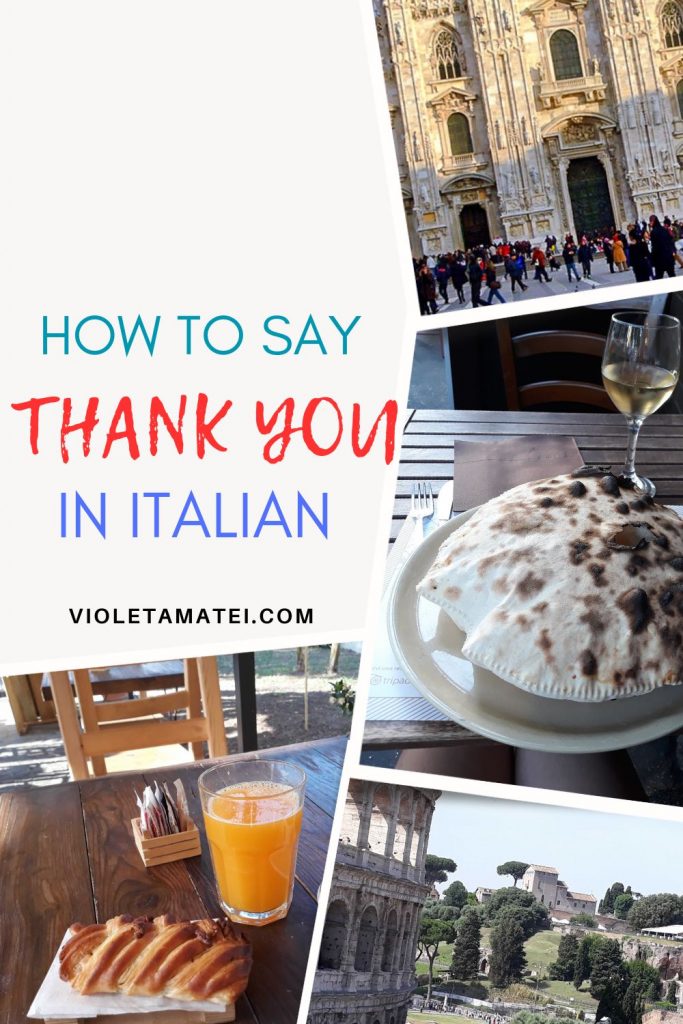Last Updated on: 7th November 2023, 05:01 pm
When learning Italian, one of the first words you learn is “grazie”, meaning “thank you”. Unless you have a romantic adventure in Italy, good reason to learn how to say I love you in Italian.
Expressing gratitude is important in any language and Italian offers many creative and colorful ways to say “thanks” in different situations. Learn a few of the most common ways of saying thank you in Italian and you’ll be able to better establish rapport with locals in Rome, Milan, Bergamo, Venice, Napoli, and all remote places and small Italian villages.
People all over the world appreciate the efforts of foreign travelers to learn their language. A few Italian words can take you a long way.
In this article, we’ll explore the various ways to say thank you in Italian, from basic expressions to more advanced forms.
You’ll discover formal and informal phrases, contractions, abbreviations, and some idiomatic expressions unique for expressing gratitude in this beautiful language.
Main Topics of How To Say Thank You in Italian: Express Your Gratitude
Common Expressions for Saying Thanks in Italian Language
Here are some of the most common ways to say thank you in Italian:
Grazie
“Grazie” is the standard, most used term for thank you in Italian.
It’s suitable for nearly all situations, from thanking a friend for a favor to showing appreciation to a waiter at a restaurant.
Grazie Mille
“Grazie mille” is an expression that emphasizes gratitude, similar to “thanks a million” in English.
It’s often used for bigger favors or when you want to show greater appreciation.
Molte Grazie
“Molte grazie” is another common variant meaning “many thanks”.
It shows sincere gratitude and is suitable for formal situations or when you want to emphasize the thank you.
Ti Ringrazio
“Ti ringrazio” is a more formal way to directly thank someone using the pronoun “ti”.
It would be appropriate in professional situations or with people you don’t know well.
La Ringrazio
“La ringrazio” is an even more formal version, using the formal pronoun “Lei” instead of the informal “tu”.
You’d use this phrase for someone you don’t know well or in very formal settings.

Learn how to say Thank You in Italian for better services and more fun
Common Abbreviations for Saying Thanks
Italians love to creatively abbreviate words and phrases. Here are some common abbreviations for saying thank you:
Grazie -> Gra
“Gra” is an informal, quick way to abbreviate “grazie”, especially in texts, chats or informal emails between friends.
Grazie Mille -> Grazie 1000 -> 1k
“Grazie 1000” is often abbreviated as “1k”, using the number 1000 instead of the full words. This is most seen in online chats or texts.
Molte Grazie -> Molte Grax -> Molte Gxe
“Molte grax” or “molte gxe” are other creative ways to abbreviate “molte grazie”, substituting the “z” with “x” or “xe”. These are also mostly used in online conversations and messaging.
Tante Grazie -> Tante Gxe
Similarly, “Tante grazie” becomes “Tante gxe” in abbreviation, using “xg” instead of “zi”. It’s a quick, informal way for youth to express gratitude.
Common Contractions of Italian Thank You Forms
Contractions, or combining two words, are also popular in Italian. Here are some ways to say thank you in contracted form:
Grazie Tante
“Grazie tante” combines the words “grazie” and “tante” and is an energetic way to say thanks, similar to “thanks a lot” in English.
Grasssie
“Grasssie” blends “grazie” and “tante” together, dropping some letters. It’s very common in speech.
Grazietante
“Grazietante” joins the words without dropping any letters. This is often seen in online messages and texts.
Graz
“Graz” is a further contraction of “grazie”, often used in short messages and chats where words need to be minimized.
Expressing Gratitude Colorfully
The Italian language is full of colorful, emphatic expressions. Here are some ways to thank more creatively and originally:
Mille Grazie!
Literally “a thousand thank yous”, it communicates intense, emphatic gratitude.
Grazie Infinite!
“Infinite thanks” poetically and elegantly emphasizes the thank you.
Grazie di Cuore!
“Di cuore” means “from the heart”, so “grazie di cuore” expresses sincere gratitude.
This is the equivalent of a Heartfelt Thank You!
Grazie Assai!
“Assai” means “very much”, so this emphatic phrase is similar to “thanks a lot!”
Grazie Tantissime!
Adding the “-issimo” suffix further emphasizes the concept, so “tantissime” grazie means “many, many thanks”.
How to Respond to “Thank You” – You’re Welcome in Italian
When someone thanks you in Italian, there are many polite ways to respond:
– Prego – Means “you’re welcome”. It’s the standard reply.
– Di Niente – Literally “it’s nothing”. Conveys you’re happy to have helped.
– Non C’è di Che – Means “don’t mention it” or “no problem”.
– Figurati – Means “don’t worry about it”. Shows the help offered was no trouble.
– Con Piacere – Means “with pleasure”, demonstrates you were glad to offer assistance.
The Importance of Saying Thank You in Italian
Whether you’re a beginner or advanced Italian learner, knowing how to express gratitude is essential.
As we’ve seen, “grazie” is just the tip of the iceberg. Italian has myriad ways to say thanks, from simple phrases to colorful exclamations.
Now you have formal and informal options, contractions, abbreviations, emphatic expressions, and responses for any situation.
Use this comprehensive guide to elevate your Italian and find the perfect “grazie†for the occasion. With your new appreciation for this important word, you can build deeper connections and leave positive impressions when interacting in Italian.
Mille grazie for reading! I’m confident that with a little practice you’ll soon be able to express appreciation like a true Italian.
If you’re interested in learning more, check out this article about Roman numerals, and prepare yourself to travel to Italy in style.
- Dingli Cliffs: How To Visit Malta’s Highest Point - April 24, 2024
- Blue Grotto Malta - April 23, 2024
- Ramla Beach Gozo, Maybe the Best in Malta - April 9, 2024

